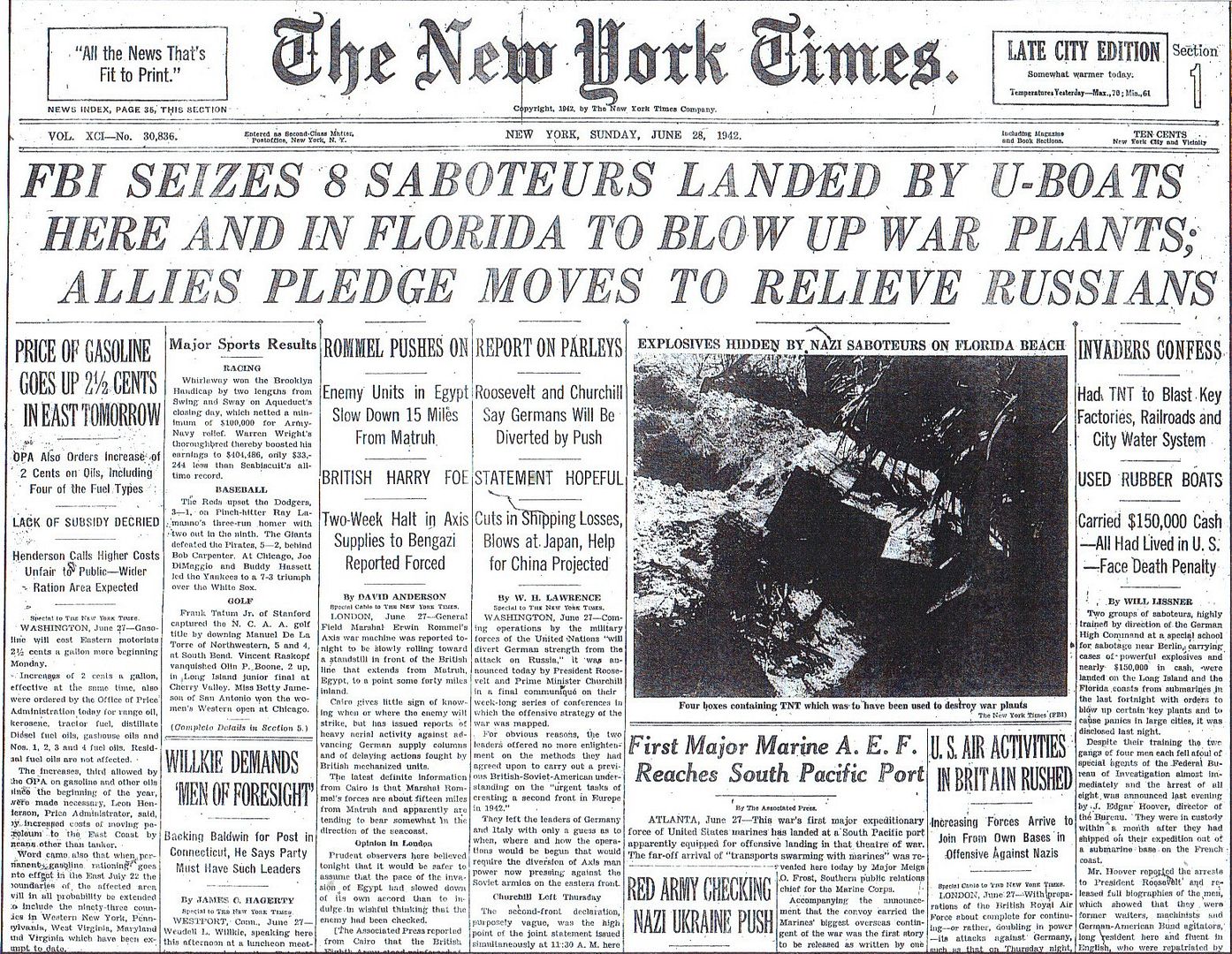
Posted on 06/28/2012 4:05:08 AM PDT by Homer_J_Simpson

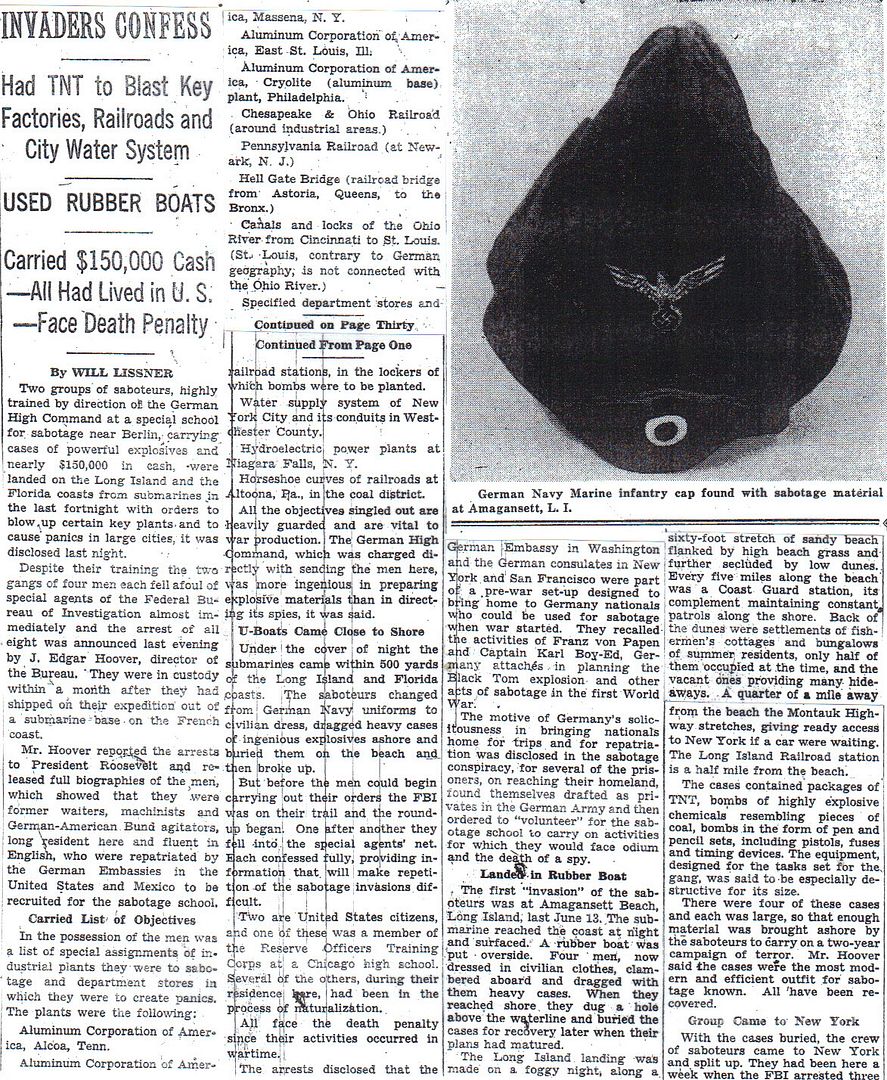
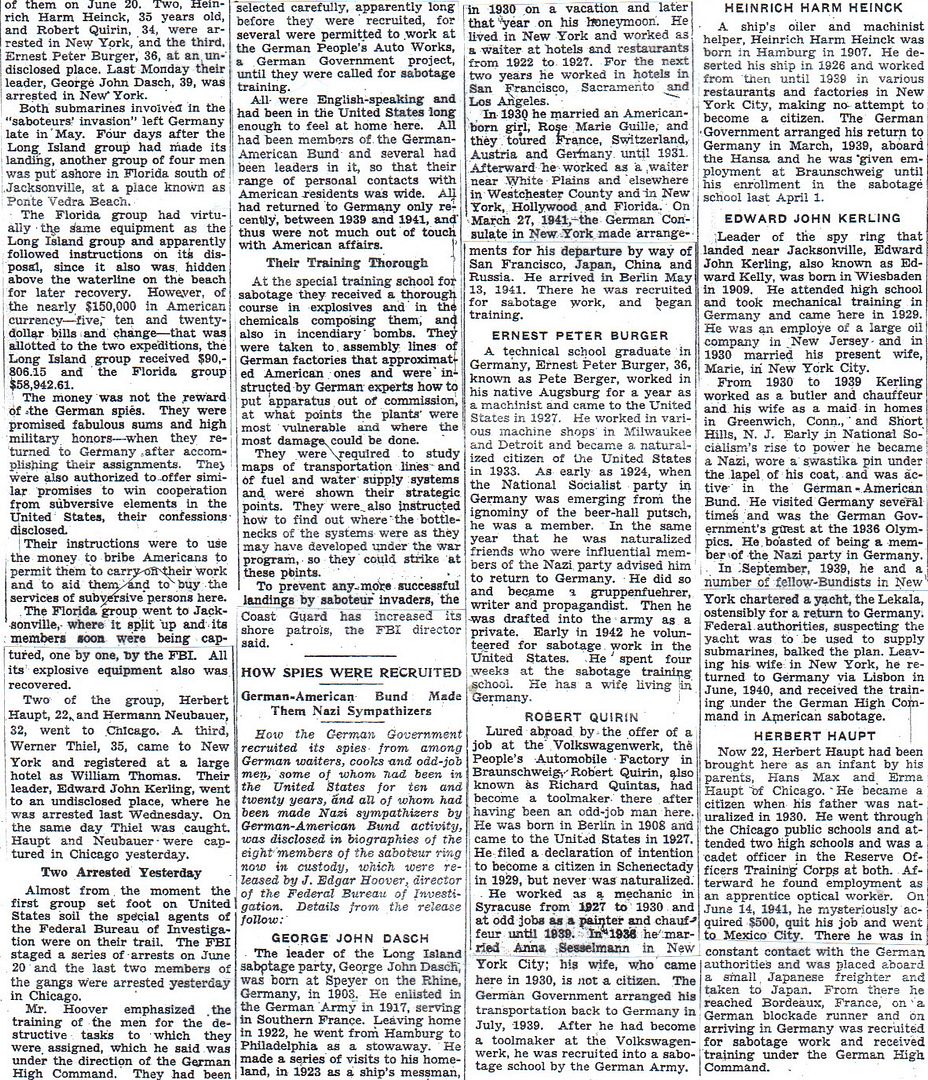
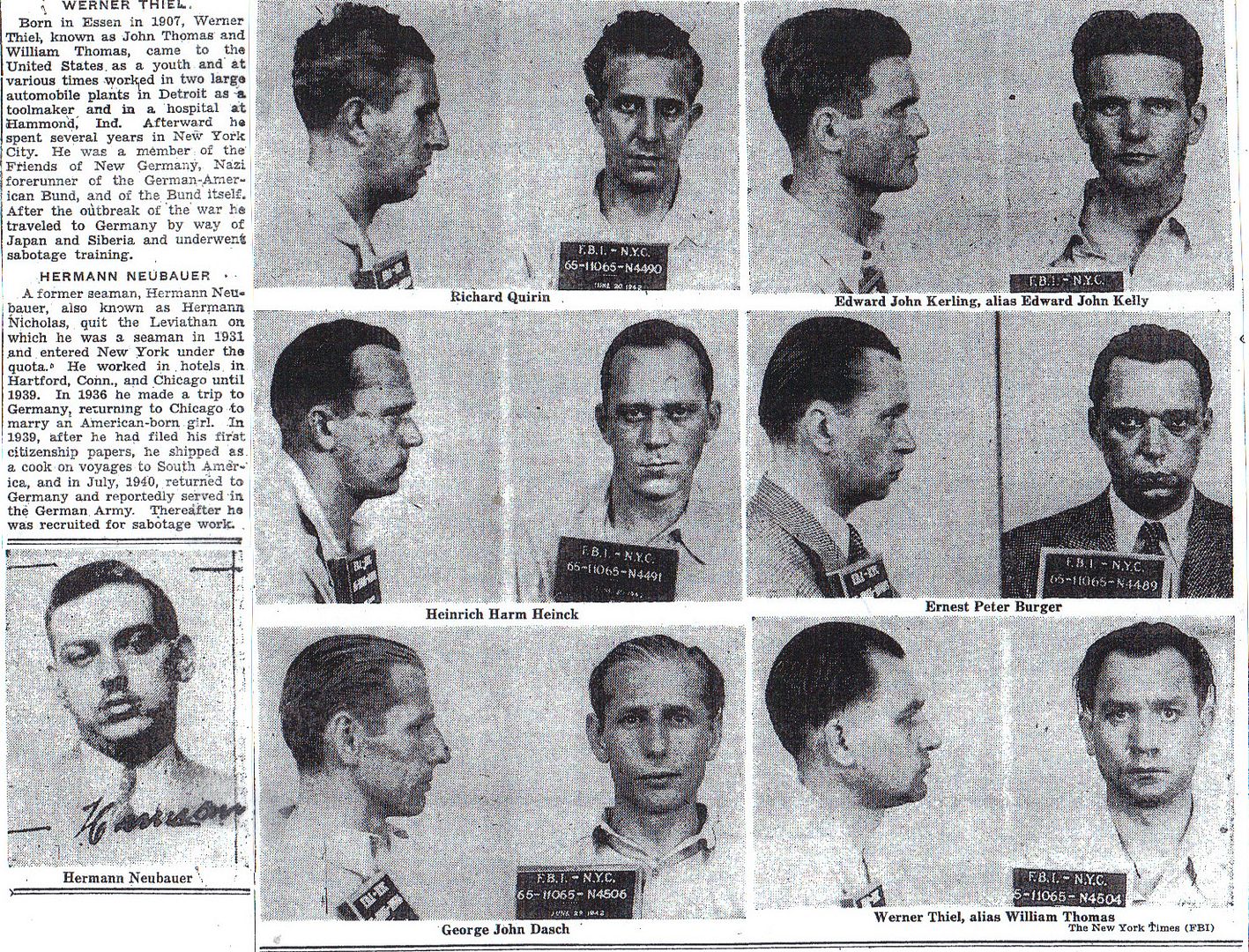


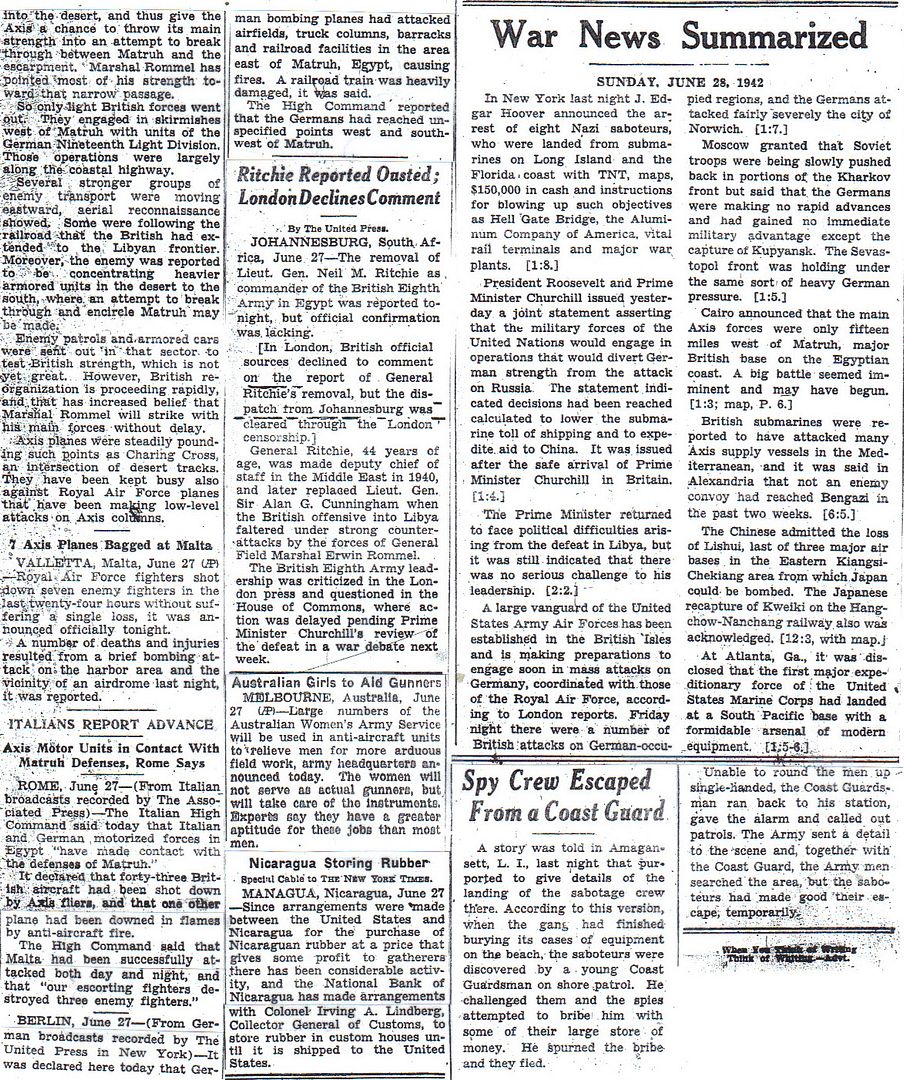











As a visiting dignitary Ike is provided with a driver by his thoughtful hosts immediately upon his arrival in England.

The News of the Week in Review
Six Campaigns in the Battle of North Africa (map) – 14
Twenty News Questions – 15
The German Armies Again Drive Toward the East (map) – 16
Germans’ Drive in Egypt Menace to Middle East (by Hanson W. Baldwin) – 17
Answers to Twenty News Questions - 18
http://www.onwar.com/chrono/1942/jun42/f28jun42.htm
Germans launch Operation Blue
Sunday, June 28, 1942 www.onwar.com
German PzKpfw III moves through burning field [photo at link]
On the Eastern Front... The main German summer offensive begins. General Bock’s Army Group South drives east from Kursk to Voronezh.
In North Africa... Mersa Matron falls to the Axis forces led by Rommel and again a large quantity of stores and equipment fall into Axis hands. All the forces in the area, the British 8th Army and the German and Italian troops are heading back toward El Alamien. It is here that British General Auchinleck has decided to take a stand.
In the Atlantic... Elements of the British Home Fleet leaves Scapa Flow to provide distant escort for PQ-17. The escort includes two battleships HMS Duke of York and USS Washington and one carrier, HMS Victorious with cruisers and destroyers.
http://homepage.ntlworld.com/andrew.etherington/frame.htm
June 28th, 1942 (SUNDAY)
UNITED KINGDOM: Lieutenant General Dwight D Eisenhower assumes command of European Theatre of Operations, US Army, succeeding Major General James E Chaney.
The British Home Fleet sails from Scapa Flow as part of the cover for PQ-17 which sailed yesterday from Iceland. HMS Duke of York, USS Washington are accompanied by carrier Victorious and an assortment of cruisers and destroyers.
U.S.S.R.: Bock’s Army Group South drives east from Kursh toward Voronezh as the main German Eastern Front summer offensive.
The Germans have unleashed their Blitzkrieg again, attacking on both sides of Kursk in the ideal tank country of the rolling Ukrainian plain. The assault, codenamed Fall Blau [Plan Blue], was opened by a storm of fire from guns and Stukas, hurried north from the siege of Sevastopol. Then the tanks struck.
General Hermann Hoth’s 4th Panzer Army, has already shattered the Russian Fortieth Army, and the Germans are heading for their first objective, the city of Voronezh which controls crossings of the Don and is a vital communications link.
The plan of Fall Blau, one of Hitler’s military visions, is extremely ambitious. It calls for an advance along the whole of the German front in south Russia, from the coast near Taganrog along the river Donets towards Kharkov and Kursk.
The units around Kursk are to make the first move, taking Voronezh and then heading down the river Don towards the city of Stalingrad. The second phase is then to come into operation with an advance into the Caucasus. The next stage envisages another double drive, one to take the oilfields of Baku and the other to reach the Turkish border at Batumi; the lack of oil is a major strategic worry for the German general staff.
To accomplish this grand vision of conquest, reinforcements have been poured into Field Marshal von Bock’s Army Group South, and it now contains almost half of the Wehrmacht’s strength in the east. Those troops are now driving forward, raising clouds of dust and leaving behind them burning villages and dead Russians. Yet it could all have ended in disaster.
Nine days ago, on 19 June, a German light aircraft carrying Major Reichel, a staff officer, was forced down over the lines. He had with him detailed orders for Fall Blau. They were rushed to Stalin. But the Soviet premier brushed them aside, dismissing them as “planted evidence.”
MEDITERRANEAN SEA: At 1316, U-97 fired a spread of two torpedoes at a convoy of three merchants with escorts (codenamed Metril) 14 miles SSW of Haifa and hit the Zealand, which sank within seconds. At 13.24 hours, a stern torpedo was fired which hit the Memas. (Dave Shirlaw)
NORTH AFRICA: In Cairo, Egypt, Major General Lewis H Brereton arrives and is placed in command of US Army, Middle East Air Forces (USAMEAF), which is activated immediately. USAMEAF is comprised of the Halverson Detachment (HALPRO), Brereton’s detachment [9th Bombardment Squadron (Heavy) and other personnel which Brereton brought from India], and the Air Section of US Military North African Mission. Also activated is Air Service Command, USAMEAF, under Brigadier General Elmer E Adler. (Jack McKillop)
B-24s of the HALPRO Detachment bomb the harbour and shipping at Tobruk, Libya. (Jack McKillop)
It was the 98th Heavy Bombardment Group, consisting of HQ, and the 343rd, 344th, 345th and 415th Squadrons.
The Afrika Corps 90th Light captures Mersa Matruh and a large store of supplies and munitions from the retreating British. The British are heading for El Alamein. General Auchinleck has decided to take a stand at the end of the rail line from Alexandria.
SOLOMON ISLANDS: A detachment of the USN’s Patrol Squadron Fourteen (VP-14) based at Noumea, New Caledonia with PBY-5 Catalinas, bombs the Japanese base at Tulagi Island. (Jack McKillop)
CANADA: Corvette HMCS Kitchener commissioned. (Dave Shirlaw)
ALEUTIAN ISLANDS: A US 11th Air Force B-17 weather aircraft flies over Kiska Island. A solid weather front cancels bombing. On this and the following day US advanced reconnaissance parties land on Adak Island from submarines. (Jack McKillop)
U.S.A.:
Destroyers USS De Haven and Harding launched.
The Tillie Lykes was reported missing after leaving Galveston and was considered lost by U-154 18 Jun 1942 in 19°N/85°W. (Dave Shirlaw)
CARIBBEAN SEA: The Canadian Lemuel J. Ritcey Co. fishing vessel Mona Marie (126 GRT), was sunk in the Caribbean Sea, south-west of Barbados, in position 12.22N, 060.10W, by gunfire from U-126, KptLt. Ernst Bauer, Knight’s Cross, CO. There were no lives lost in this incident. U-126 was a long-range Type IXC submarine built by AG Weser, at Bremen. She was commissioned on 22 Mar 41, KptLt. Ernst Bauser, CO. U-126 conducted six patrols and compiled an impressive record of 26 ships sunk for a total of 125,837 tons and five ships damaged for a further 37,501 tons. U-126, OLtzS. Siegfried Kietz, CO, was sunk 03 Jul 43, north-west of Cape Ortegal, Spain, in position 46.02N, 011.23W, by depth charges from a British ‘Wellington’ patrol aircraft from RAF 172 Squadron. All of U-126’s 55 crewmembers were lost. Ernst Bauer was born in 1914, at Fürth, in Bavaria. He joined the navy in 1933 and, after more than a year in the light cruiser Königsberg, transferred to the U-boat force in 1938. He served as a Watch Officer in U-10 and U-37 before commissioning the Type IIB training boat U-120, on 20 Apr 40. Bauer left U-120 in November 1940 and then commissioned the long-range Type IXC boat U-126 on 22 Mar 41, at the age of 27. He conducted five successful patrols with U-126, operating mostly in Caribbean and African waters. He was awarded the Knight’s Cross on 16 Mar 42 (the 47th presented in the U-boat force). Bauer completed his tour of duty in U-126 in March 1943 and was assigned as a training officer in the 27th U-boat Flotilla. In October 1944, he was appointed to command the 27th Flotilla. Bauer was promoted to KKpt. on 01 Apr 45 and during the last days of war he was transferred to the 26th U-Flotilla. In 1955, Bauer joined the German Bundesmarine and held several staff positions, retiring in 1972 in the rank of Kapitän zur See. He died on 12 Mar 1998, at Westerland/Sylt. Ernst Bauer sank 25 ships for a total of 118,660 tons and damaged four ships for a further 31,304 tons, making him the 25th highest U-boat ace of the war. (Dave Shirlaw)
ATLANTIC OCEAN: U-67 encountered an enemy submarine in the North Atlantic, but neither boat attacked.
U-332 helped some shipwrecked seamen with water and food in the West Atlantic.
On U-596 a battery explosion forced the boat to return to base.
Five U.S. merchant vessels are sunk by German submarines in the Atlantic.
U-201 sinks a freighter east of Puerto Rico;
U-153 sinks an armed freighter 100 miles (161 km) off Cuba; the sub crew rescues one survivor and places him in a lifeboat with three shipmates. These are the only survivors of the 38 men aboard.
At 1538, the unescorted Sam Houston, on her maiden voyage, was hit by one torpedo from U-203 about 160 miles NE of the Virgin Islands. The torpedo struck the bulkhead between the engine room and the #4 deep tank, killed one officer and two men on watch below and caused fires in the cargo. As the #4 hold and the engine room flooded the ship first developed a slight list but the ship righted herself and remained on even keel with the deck only two feet above water. The survivors among the eight officers, 29 crewmen and nine armed guards (the ship was armed with one 4in and four 20mm guns) aboard abandoned ship after 15 minutes in three lifeboats. At 1600, the U-boat surfaced and sank the ship with 43 rounds from the deck gun. The Germans took the master on board for questioning and put him later back into a boat. Four crewmen died from burns in the lifeboats before the survivors were picked up after two days by minesweeper USS Courier and landed at St. Thomas, where another crewman died of burns in a hospital.
At 1030, the unescorted and unarmed Raphael Semmes was hit on the starboard side by two torpedoes from U-332 when steaming on a non evasive course at 9 knots about 875 miles east of Cape Canaveral, Florida. The torpedoes struck at the #2 and #4 hatch and caused the ship to sink within two minutes. The nine officers, 26 crewmen and two passengers unsuccessfully tried to launch boats but had to jump overboard and swim away from the ship. 18 survivors clung to wreckage and eventually climbed onto two rafts, ten of them with the help of the U-boat that circled the wreck and picked them up. The Germans took care of their wounds and gave them tobacco, cigarettes, water and food before leaving the area. The 18 survivors were picked up on 16 July by the American steam merchant Explorer and landed them two days later at Jersey City, New Jersey. The master, six officers, eleven crewmen and one passenger were lost.
At 1855, the unescorted Sea Thrush was hit on the port side forward of the collision bulkhead by one torpedo from U-505 about 425 miles NE of San Juan, Puerto Rico. The eight officers, 33 crewmen, eleven armed guards (the ship was armed with one 4in, four 20mm and two .30cal guns) and 14 passengers (US Army officers and technicians) abandoned ship in four lifeboats. At 2000, the U-boat fired a coup de grâce that hit on the starboard side in the #2 hold and caused the ship to break in two and sink immediately. The survivors in three of the boats were picked up after 48 hours by USS Surprise and landed in San Juan. The remaining 16 survivors in the last boat were spotted by a patrol aircraft about 8 miles off St. Thomas, Virgin Islands and were brought to the island by a rescue craft on 3 July.
Armed steam tanker William Rockefeller sunk by U-701 off North Carolina at 35.07N, 75.07W.
(Jack McKillop and Dave Shirlaw)
Any other battleships getting set to cover PQ 17?
"Hitler's fury over the Heydrich assassination was vented in Lidice.
The Czech village was brutally destroyed in a murderous burst of revenge carried out by SS and police.
On June 9-10, 1942, 199 of the village's adult males and 47 of its women were executed.
The remaining women were imprisoned in the Ravensbrück concentration camp, and the children--only 16 of whom would survive the war--were sent to "educational" institutions.
The murdered citizens of Lidice were laid out in rows before being buried in a mass grave."
"An unfinished apartment complex in the Paris suburb of Drancy was a transit camp for most Jews shipped from France to Auschwitz.
From 1942 to 1944, more than 60 of the 79 trains that left for the East from France left from Drancy.
About 67,000 of 75,000 Jews deported from French soil spent time at Drancy.
"When Drancy opened on August 21, 1941, living conditions were abysmal.
There were 1200 wooden bunk-bed frames for the first 4000 inmates.
Forty to 50 internees crammed each room, and their diet consisted exclusively of cabbage soup.
As a result, the mortality rate at Drancy was very high.
"Ironically, material conditions improved when German officials took over camp administration from Vichy France officials in July 1943.
The last deportation transport left Drancy on July 31, 1944."
We used to have a coworker in our office who was a former FBI agent. Whenever something hot would break and we went to an almost all hands on deck approach with dealing with the supposed problem, he would exclaim: “Wow, this is probably bigger than the Nazi U Boats landing saboteurs on Long Island”.
The first German in the photograph will be the named party in the legal case that will go all the way to the United States Supreme Court, and the case will proceed in an expedited fashion not known today. They will be charged on July 2, tried, convicted and sentenced to death July 9.
The last appeal of these gentlemen will be decided as EX PARTE QUIRIN, 317 U.S. 1 (1942). It was decided July 31, 1942, and the full opinion was delivered October 29, 1942. It was a Per Curiam opinion, meaning that it is considered a summary disposition of the Court, and there is no dissent.
The issues presented:
“Petitioners’ main contention is that the President is without any statutory or constitutional authority to order the petitioners to be tried by military tribunal for offenses with which they are charged; that in consequence they are entitled to be tried in the civil courts with the safeguards, including trial by jury, which the Fifth and Sixth Amendments guarantee to all persons charged in such courts with criminal offenses. In any case it is urged that the President’s Order, in prescribing the procedure of the Commission and the method for review of its findings and sentence, and the proceedings of the Commission under the Order, conflict with Articles of War adopted by Congress-particularly Articles 38, 43, 46, 50 1/2 and 70-and are illegal and void.”
After going through legal analysis shooting down the claims of the German saboteurs, the Court concludes:
“Accordingly, we conclude that Charge I, on which petitioners were detained for trial by the Military Commission, alleged an offense which the President is authorized to order tried by military commission; that his Order convening the Commission was a lawful order and that the Commission was lawfully constituted; that the petitioners were held in lawful custody and did not show cause for their discharge. It follows that the orders of the District Court should be affirmed, and that leave to file petitions for habeas corpus in this Court should be denied.”
In re Quirin will be cited again in APPLICATION OF YAMASHITA, 327 U.S. 1 (1946), 327 U.S. 1 , which was the appeal of Gen. Tomoyuki Yamashita from MacArthur’s war tribunal sentencing him to death (which was a 6-2 decision, the dissent is worth reading).
Ex Parte Quirin became relevant again in regard to the detention and trial by military tribunal of the “combatants” held in Guantanamo. I really don’t know what all the legal hue and cry is over the legality of Guantanamo, the tribunals or their authority. Quirin was an enemy combatant, and therefore entitled to more “rights” by the Articles of War than the Guantanamo terrorists, who are NOT combatants and not entitled to protection under the Articles of War. But the salient point of Ex Parte Quirin is that such persons are clearly NOT entitled to the full panoply of criminal rights guaranteed by the Fourth, Fifth, Sixth and Eighth Amendments to the United States Constitution. Legal scholars use the term “dispositive,” meaning “this exact issue has already been clearly decided and is not subject to further discussion.”
You can read the full opinion of Ex Parte Quirin here:
http://caselaw.lp.findlaw.com/scripts/getcase.pl?court=us&vol=317&invol=1
In looking for some information on the bund organization found the following:
http://rexcurry.net/pledgebund.html
At the bottom is a reminder that Nazi were socialists. The Nazi symbol was two letter s’s signifying socialism.
In the 30’s many called themselves german american, not so much during the war years.......................
There is a reference in the above article that the extended arm salute was common in the USA and changed in 1942 to the hand over heart. The below seems to verify that:
http://en.wikipedia.org/wiki/Bellamy_salute
It is a wonder that sabatoge didn't happen more often. Maybe this one time didn't work so the Nazi just didn't try again?
Actually, Dasch called the FBI to turn himself in, and the FBI initially didn't believe him, until he dumped a large sum of money on their desks.
Two of the men, Dasch and Berger were not executed, but repatriated by Truman.
Nylon for the War Effort ! - Princess Gouriellis’ Waterproof Leg Tint on Sale!
Disclaimer: Opinions posted on Free Republic are those of the individual posters and do not necessarily represent the opinion of Free Republic or its management. All materials posted herein are protected by copyright law and the exemption for fair use of copyrighted works.